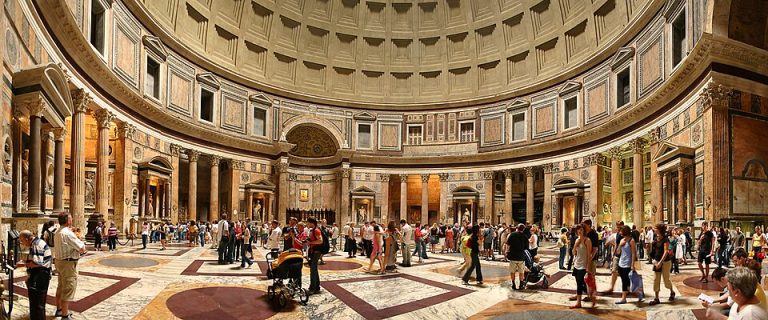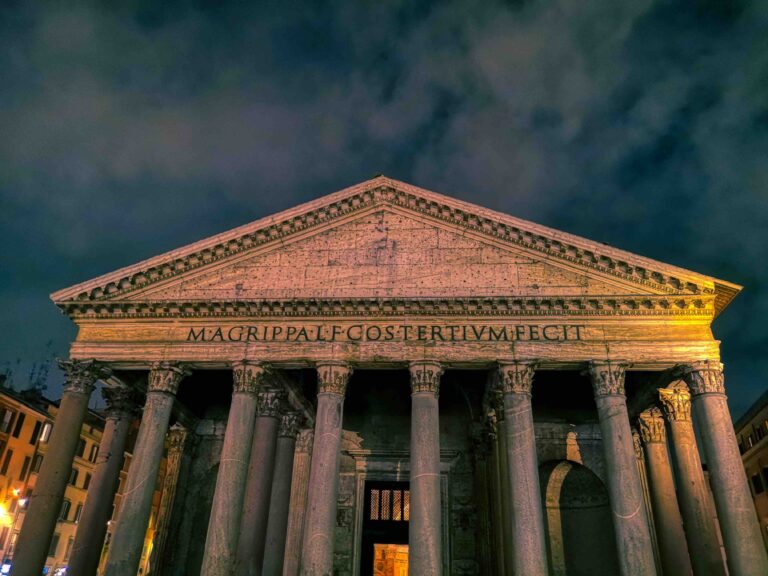The Pantheon in Rome sits right in the middle of Rome’s busy city life, yet stepping inside this legendary building feels like entering another era. While a lot of people know its famous dome and striking columns from photos, seeing it in person adds a whole new layer to the experience. The Pantheon blends ancient engineering, religious history, and modern Italian culture in ways that are hard to put into words but super cool to explore. Here, I’m putting together everything I think travelers and history fans would want to know, plus a few personal insights on what makes the place extra memorable.

What Does “Pantheon” Really Mean?
Straight out of ancient Greek, “pantheon” literally means “all the gods.” In ancient Rome, a pantheon was a temple where people could worship any god, rather than just one. So, when folks ask about the Pantheon definition or Pantheon meaning, it’s all about being inclusive—a spot open to every deity, which was pretty rare back in ancient times. Today, the Pantheon in Rome is one of the world’s only ancient temples that’s survived almost entirely intact, even after about two thousand years of history, transformations, and changing faiths. The name “Pantheon” stands as a reminder of that wide embrace. Over time, the very idea of a pantheon has come to symbolize a gathering of excellence or notable figures, not just deities.
The History: When Was the Pantheon in Rome Built?
The moment people walk up to those massive columns, they usually ask, “When was the Pantheon in Rome built?” The first version of the Pantheon went up in 27 BCE under Agrippa (a Roman general and right-hand man to Emperor Augustus), but that building was destroyed by fire. What you see today mostly dates from around 118–125 CE, built under Emperor Hadrian. Inscriptions over the entrance still credit Agrippa, which is a neat throwback to its roots, even if most of the current building is Hadrian’s work. It’s switched from being a temple for every Roman god, to a Christian church, to basically a living piece of architecture, artwork, and community life. Over the centuries, the Pantheon has seen many uses, from royal ceremonies to scientific experiments, making its story even more colorful and layered.
Pantheon Architecture: Cool Features Worth Checking Out
The Pantheon’s dome is probably what makes most jaws drop. Until modern times, it was the biggest unreinforced concrete dome in the world—still wild to think about. The huge oculus (the open skylight at the center of the dome) isn’t just there for light. It also helps relieve weight from the dome and creates the Pantheon’s iconic shaft of daylight that feels sort of magical every time you walk in. The way the Romans managed such precise engineering without today’s tech is genuinely amazing. Details like the perfect symmetry of the rotunda, the beautiful marble floors, and all the original Roman columns show off techniques that architects still study. The fact that the building has stood for nearly two thousand years, surviving earthquakes, invasions, and shifting rulers, is a tribute to the ingenuity of its designers. The proportions inside the rotunda—where the height equals the diameter—create an impressive sense of balance. Standing under the oculus, you may notice how the light shifts with the time of day, making each visit unique. Rain sometimes falls inside, but a clever system of drains in the marble floor carries the water away, leaving the interior dry and visitors amazed.
What is There to Do at the Pantheon in Rome?
A visit isn’t only about admiring the dome. The Pantheon is a bustling place with a steady flow of Pantheon show, meaning daily ceremonies and regular Masses since it became an official Christian church (Basilica di Santa Maria ad Martyres) in the 7th century. Sometimes, I’ve caught live organ music inside, which surprisingly adds to the centuries-old atmosphere. If you’re there during Pentecost, you might see rose petals pouring through the oculus, a Roman tradition that’s one of the most eye-catching in the city. It’s also the resting place of famous Italians, including Renaissance artist Raphael and former Italian kings, so you can spend as long as you want exploring tombs, art, and, of course, snapping photos of the interior. When the crowds surge, stepping aside in one of the side chapels gives you a quiet moment to take it all in. Enthusiasts who really want to dig into the details may want to check out the altar’s decorations, the inscription honoring Agrippa, or the frescoes on the walls—details that give a boost to the temple’s atmosphere. Guided tours are available, and audio guides let you listen in as you walk the mosaic floors, picking up facts you wouldn’t easily stumble upon by just looking around.
Getting to the Pantheon: How to Find It On the Map
The map of Pantheon Rome is actually pretty simple. The Pantheon sits in Piazza della Rotonda, close to many of Rome’s other blockbuster sites like Piazza Navona and the Trevi Fountain. Even without GPS, ask almost any local, and you’ll get directed straight to it. The area around the Pantheon is easy to walk, filled with winding cobbled streets, little gelato shops, and street musicians. Public buses and taxis can stop nearby, but the best way in my opinion is just to wander there on foot and soak up the feel of the historic center as you go. Getting lost in the maze of nearby alleyways is half the fun, as you can spot hidden gems like tiny fountains or artisan shops. Whether you are following a paper map, a smartphone app, or just your sense of wanderlust, you’ll probably hear the buzz of the square before you see the Pantheon’s portico rising up ahead.
Pantheon Rome Opening Hours and Visitor Tips
Pantheon Rome opening hours are updated often, but usually run from around 9 a.m. to 7 p.m. every day, with the last entry about 30 minutes before closing. On Sundays, the place may close earlier for church services, so checking official hours in advance saves a lot of hassle. Entry is generally free, but sometimes special exhibitions or events come with a small fee. Weekends see the largest crowds, so hitting the Pantheon early on a weekday works best if you want to snap crowd-free pictures. Dress respectfully when you visit, since it’s still an active church, and be prepared for a quick security check at the entrance. For accessibility, ramps and courteous staff help smooth the way for those who need assistance, and there’s usually signage in English and Italian. Pair your visit with a nearby café stop, and you have the makings of a perfect Roman morning.
Where to Stay: Hotels Near Pantheon Rome
Finding hotels near Pantheon Rome is honestly a pretty easy task since the area is one of the city’s most popular places to stay. You can find everything from stylish boutique hotels, like Albergo del Senato, to affordable guesthouses tucked behind historic facades. If you’re visiting for the city’s history and want to stroll to nearly every landmark, picking a hotel within a five-minute walk of the Pantheon is honestly a smart move. It’s a super handy location for sightseeing, dining, and hopping on public transit, plus you get the magical experience of strolling by the Pantheon after dark when crowds are gone. Best of all, many hotels offer rooftop terraces with gorgeous views over the ancient rooftops of the city. Whether you’re seeking old-school charm or modern luxury, the neighborhoods around the Pantheon deliver a range of choices to suit most travelers.
Eating Out: Restaurants Near Pantheon Rome
Packed with classic trattorias, gelato stands, and espresso bars, the cluster of restaurants near Pantheon Rome gives you a crash course in Roman food culture. My go-to choice after wandering the Pantheon is grabbing a thin, crispy Roman pizza or popping into Tazza d’Oro for some of the city’s best granita di caffè (think sweet coffee slush). The square in front of the Pantheon gets busy with tourists, but a few alleys away you’ll find oldschool cafes and spots where locals linger over plates of carbonara or amatriciana. Tasting the local specialties just steps from one of Rome’s most iconic landmarks makes the whole experience even better. Plus, many restaurants have outdoor seating, perfect for people-watching or simply soaking up the scene. Don’t be afraid to ask waiters for recommendations—they usually love pointing out seasonal dishes or house favorites you might not otherwise try.
Practical Travel Tips for Visiting the Rome Pantheon
- Bring a Camera: You’ll want to capture the oculus and dome, but also the light and shadows around sunset or sunrise.
- Dress Smart: Shoulders and knees should be covered inside, especially during services or busy tourist hours.
- Beat the Crowds: Early mornings or late evenings are usually quieter, and there’s just something about seeing the dome glow in the morning sun.
- Audio Guides: Free (or inexpensive) audio guides from the Pantheon’s official website help add real context to what you’re seeing.
- Check Event Schedules: Religious ceremonies can mean restricted access, so plan around those if you want to see every corner inside.
Frequently Asked Questions About the Pantheon in Rome
Is the Pantheon still used for services?
Yep, it’s an active Catholic basilica. You can attend Mass, and some special ceremonies, like weddings, are held there too.
Do you need tickets for the Pantheon?
Usually, entrance is free, but some exhibition days or events ask for a small ticket fee. Checking the official Pantheon site before your trip is a good move.
How long does it take to visit?
If you’re just poking in for photos, 20–30 minutes is fine. History fans (like me) often spend an hour or more, especially if you want to take in every detail or visit one of the nearby cafes after.
Can you take pictures inside?
You’re totally allowed to take non-flash photos; drones and tripods are not allowed inside, though, so just bring your phone or camera and enjoy.
The Pantheon in Modern Rome
The Pantheon isn’t just sitting around as an ancient relic. Roman locals and the city’s visitors genuinely interact with the space every day, as a church, a tourist highlight, and an anchor point in the city’s geography and daily life. While you can see replicas and miniatures around the world, the real thing in the heart of Rome feels both grand and surprisingly accessible. It’s a solid reminder that some places just have staying power, offering a blend of architecture, history, and atmosphere that’s tough to capture anywhere else. Pair your visit with time wandering nearby plazas, eating local food, and just hanging out under the shadow of Rome’s dome, and you’ll get a sense of why people feel a little awe-struck every time they walk through those doors. Wrapping up, whether you’re a history buff, an architecture fan, or a first-time visitor, the Pantheon always has something new to stumble upon and appreciate—making it a must-see in Rome every single time.






